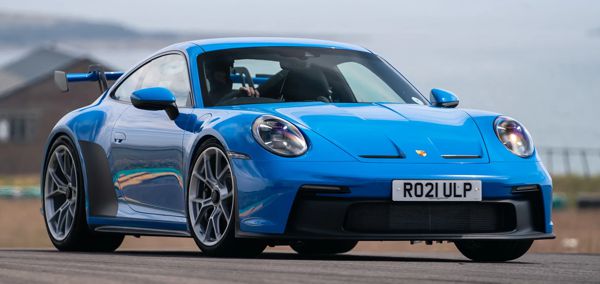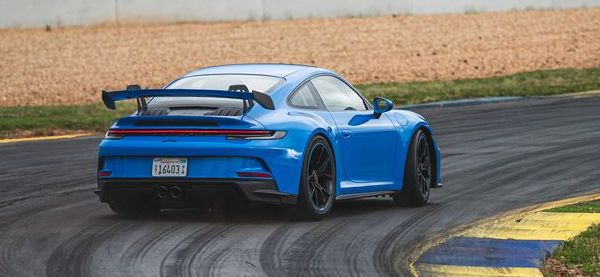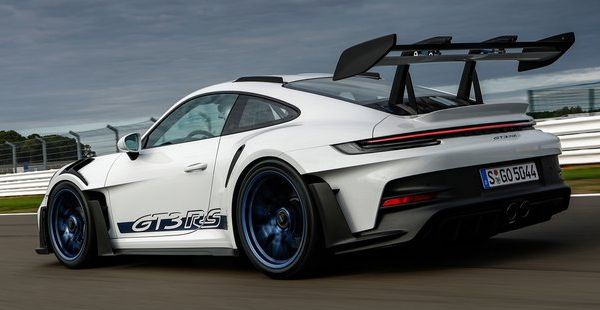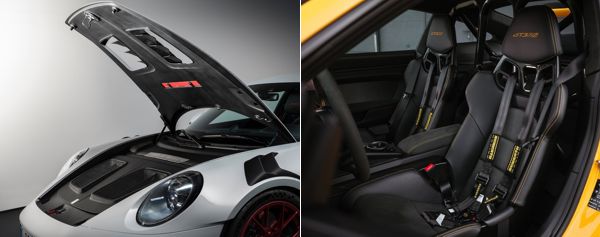Published
on 14
Sep 2021
|
All rights reserved.
|
|
|

|
|
22
years on, the GT3 remains the hardcore choice of Porsche drivers, just
getting even more hardcore now.
|
|
Since it was born in
1999, the GT3 has been the definitive road and track car any money can
buy, blending race car performance and thrills with road car usability
better than any others. Throughout the years, the outside world has
changed a lot, especially to turbocharging and then hybrid power.
Countless
of electronics and refinement are added together with weight. The GT3
cannot escape from modernization, but fortunately, some good things
never change, such as the high-revving naturally aspirated flat-six,
the manual gearbox (though briefly lost from 2013-2017) and the classic
rear-engined, rear-wheel-drive layout. And brilliantly, today’s GT3 has
gained only 68 kilograms from its ancestor
of 1999, even though it is
quite a bit larger. Price has risen more sharply lately, but at
£128,000, it is not far removed from the £76,500 charged 22
years ago.
While the 9000-rpm motor used to be the highlight of the car, no longer
this time. Don’t get me wrong, it is just as creamy-smooth,
intoxicatingly revvy and razor-sharp responsive as before, but it is
not exactly a new development. In fact, it was introduced 2 years ago
on the limited edition 991.2
Speedster. Its key modifications from
earlier versions are individual throttle bodies (for even sharper
throttle response), higher fuel injection pressure and adaptation to
comply with stricter emission standards. The latter was achieved mainly
by adding a pair of gasoline particulate filters close to the engine.
The 992 GT3 keeps that engine, therefore it has exactly the same output
of 510 horsepower at 8400 rpm and 347 pound-foot of peak torque, which
is merely 10 ponies and 7 lbft more than the last GT3. The only
difference is using a stainless steel exhaust instead of the
Speedster’s titanium item. Thanks to the silencing effect of
particulate filters, the exhaust can abandon silencers, recouping the
loss of exhaust noise while cutting 10 kilograms.

|
|
Engine
is transplanted directly from 991.2 Speedster.
|
|
Speaking
of weight reduction, the 992 GT3 works harder than ever. It needs so,
because it has a wider body, a more sophisticated front suspension
(more on that later) and other chassis enhancement that would have
added 40kg to the kerb weight. The diet program includes a carbon-fiber
front bonnet (-2.5kg), lithium battery (-10kg), lighter engine mounts
(-3.5kg), thinner glass (-4.7kg), single-nut forged alloy wheels
(-1.3kg) and brakes which weigh 17 percent less despite the front discs
have grown from 380 to 408mm. To keep weight low, it skips the 8-speed
PDK and 7-speed manual gearbox of other 911s for the lighter 7-speed
PDK and 6-speed manual of the old car. Overall, the car tips the scale
at 1418 or 1435 kilograms depending on transmission, which is only 5kg
more than its predecessor. And that’s before you consider lightweight
options like PCCB brakes and a carbon-fiber roof panel.
With a virtually unchanged power-to-weight ratio, you can see why
Porsche quotes exactly the same performance figures as the last
generation. The PDK car is again quicker of the two, achieving 0-60 and
0-100 mph in 3.2 and 7.0 seconds, respectively while topping 198 mph.
The 6-speed manual needs 3.7 and 7.9 seconds respectively but its top
speed is 1 mph higher. So the decision is easy: if you chase after
absolute performance, go for the PDK. If you pursue driving fun in the
first place, the manual is always the one to have, especially you know
Porsche offers first-class gearshifts.
So this is the first time in the GT3’s history that its straight line
performance is no higher than the car it replaces. Is it the end of the
world? No, of course not, because the highlight of 992 GT3 is cornering
performance. Believe or not, despite virtually no more power available,
this car laps the new, 20.8km Nurburgring in 6:59.9 or the old 20.6km
course in 6:55.2, not only rated among the fastest road cars on earth
regardless of power and price, but it is a full 17 seconds quicker than
its predecessor ! How can it do that?
|
|
|
Extensive
weight saving keeps it relatively light for a 500hp sports car.
|
|
3 reasons: more downforce, more grip and more suspension.
More than ever, this GT3 looks closer to a track car in appearance. The
large black nose section that integrates cooling intake and adjustable
front splitter trades some road car aesthetic for aerodynamic
efficiency. Ditto the 2 slots opened at the leading edge of the front
bonnet. At the back, it employs a large rear wing which would have felt
more suitable to a GT3 RS. That wing is suspended from the top by
aluminum brackets, leaving a smooth underside for improved efficiency.
It is also manually adjustable to 4 angles. In the most aggressive
angle, the car generates 385kg of downforce at 124 mph, compared with
154kg on the old car. In fact, more than the outgoing GT3 RS.
The second trick is the use of beefier and stickier rubbers. Yes, the
Nurburgring lap time was set by using more track-oriented Michelin Cup
2 R tires, but even the standard Cup 2 tires should hold the road
harder, because they have grown 10mm wider and 1-inch larger in
diameter to 255/35ZR20 up front and 315/30ZR21 at the rear. In
pictures, the huge rear wheels look really astonishing, filling the
pronounced wheel arches so full.
|
|
|
Handling
and ride transformed by double-wishbones front suspension.
|
|
But the
most radical change in this generation has to be the front suspension.
Not only its track has been widened by 48mm, but it has abandoned the
911’s traditional MacPherson struts (since 1963, remember) for a
double-wishbone setup that comes from the RSR race car. No doubt the
racing program has polished this concept and proved its superiority
before the GT division made this bold decision. The control arms are
attached to the monocoque body by rigid ball joints to eliminate slack
and enhance precision. Its new geometry keeps the front tires pressing
on the road under rigorous conditions, resulting in more traction, more
grip and a more stable manner. Of course, when introducing an all-new
front suspension, Porsche needs also to rework
the rear suspension geometry and calibration to make them working in
harmony. Ditto the steering rack, the active rear-wheel steering, the
stability control and PASM adaptive dampers. The huge downforce at
speed also requires stiffer springs to cope with. All in all, it is
like developing a new chassis from ground up.
On the road, all these changes, especially the new suspension, have
transformed the GT3 into something even veteran Porsche drivers take
some getting used to. While the motor is so familiar and its amazing
voice is fortunately not hampered by the particulate filters, while the
quick and seamless gearshift response is also familiar, the chassis
feels like coming from another car. For better or worse, it feels like
a track car – stiff riding in any suspension mode, barely acceptable on
a public road, and probably unbearable for a half-day driving on
B-roads. Whether such a stiffness is absolutely necessary to take on
that tremendous downforce, I am not sure, because McLaren seems to
manage huge downforce more comfortably. The cabin is noisy, too, thanks
to removing most of the sound deadening materials.
 |
|
Faster,
more accurate and more focused, but also more removed from road driving.
|
|
However,
it is undeniable that the 992 GT3 drives a lot more accurate, hence a
lot faster on any roads you can bear. More like a race car, actually.
Its body control is just as tight as any supercars made of exotic
materials and have their engines mounted in the middle. Its roadholding
is massive, especially at faster corners where downforce builds up. Its
steering, while noticeably lighter, is quicker and swiss-watch
accurate. It is super-talkative, too, relaying all the road surface
information you need to know but also those you are not interested.
Just as the suspension, it feels busy, and you have to be focused.
When it comes to cornering, the 992 GT3 shows jaw-dropping grip and
traction. Its turn-in is sharper and more accurate than any GT3s before
it. Tremendous front-end grip puts it on rails and the rear axle
follows obediently. Whereas you expect the old car to run out of grip
and push its nose wide, the new car keeps turning, turning. No 911s
could be described as neutral, but this one is the closest yet. It
balances like a mid-engined car.
The bad news is, its much higher limits takes much bigger speeds and
efforts to exceed. On a dry public road, this is simply impossible.
Only on a track, you can explore its true balance beyond limits. When
the big rear rubbers are finally unstuck from the tarmac, it slides
progressively. Keep feeding power and you can hold the slide. Back off
a little and it straightens. It is friendly and reassuring at the limit.
Undoubtedly, the 992 GT3 is a much better track weapon, significantly
faster and sharper. However, at the same time it
moves away from the road, losing the fine-judged ride quality and
general refinement that made its predecessors equally enjoyable on road
and track. In fact, it feels more like an RS now. I wonder what space
has left for the next RS. If I were McLaren or Lotus, I would
definitely take this opportunity to fill the space it left.
|
Verdict:      |
Published
on 28
Oct 2022
|
All rights reserved.
|
|
911 GT3 RS
|
|

|
|
More
race car than the real race car.
|
|
If you tell me this is a
911 road car a few years back, I would say you are crazy. No, with
those huge wings, ducts and vents, it must be a Porsche GT3 Cup race
car, unquestionably.
The most ridiculous thing about the new 992 GT3 RS is not its race car
looks, but it packs specifications beyond the racing version. Because
it is not limited by engine air restrictors and aerodynamic
regulations, it actually produces more horsepower and downforce than
the GT3 Cup race car. Although it carries a little more weight, Porsche
reckons it will destroy the Cup car on track, even though it is shod
with semi-slick Michelin Cup 2 R tires instead of the slicks of Cup
car. Astonishing.
If you don’t believe, look at its latest Nurburgring lap time. It takes
6:44.8 to lap the old 20.6 km course, 11.6 seconds quicker than the
last GT3 RS, 10.4 seconds faster than the current GT3 and trails the
current record holder AMG
GT Black series by only 1.2 second – don’t
forget the AMG employs a twin-turbo V8 with 730 horsepower, versus the
Porsche’s 525 horsepower from a naturally aspirated flat-6. If not
race-car downforce and handling, this would not have been possible.
The Renn Sport (aka RS) label has been around since 1973, and it became
the hardcore, track-oriented version of GT3 since 2003. In the past 19
years, 6 iterations of GT3 RS had been created. All of them employed a
high-revving naturally aspirated motor. However, the last 3 iterations
saturated at 4.0 liters and produced around 500 horsepower. Maybe it
runs out of development potential, or Porsche has simply stopped
developing it in the view of ICE ban by 2030, extra performance has to
be extracted from else where. That’s why the new RS pushes
aerodynamics to the extreme.
The aero package is astonishing. Its rear wing is so huge that spans
the entire width of the car. It is also mounted higher than the car
itself, probably the highest we have seen since Dodge Daytona. This
lets it
exposed to clean air and enhances downforce a lot. Moreover, by using
swanneck brackets to suspend the wing, it leaves a smooth underside to
enhance efficiency further. The wing has 2 planes, the lower one
is adjustable by hydraulic to alter drag and downforce. As in Formula
One’s DRS, you can switch it to horizontal position by pressing a
button, so to reduce drag for passing or achieve top speed.

|
|
It
takes a McLaren Senna or Aston Martin Valkyrie to offer more downforce.
|
|
The rear wing and the likes contribute to 70 percent downforce. The
remaining 30 percent comes from the front of the car. Here, the most
dramatic change is ditching the luggage compartment entirely and
replace it with a centrally-mounted radiator. The latter is 43-degree
tilted to increase surface area, so that the new GT3 RS can skip the 2
extra side radiators that its predecessors required. In this way, it
can add downforce-generating aero flaps to the sides of front overhang.
These flaps are adjustable and part of the active aerodynamics, working
in harmony with the active rear wing to keep the car balanced.
Meanwhile, the radiator arrangement also helps generating downforce. It
sucks air from the central intake at front bumper and extracts at the
bonnet outlets. Note that some strange-looking vane guides are added to
the outlets. They are used to deflect the hot air sideways, preventing
them from passing the roof and sucked into the engine bay. It goes
without saying a naturally aspirated motor needs cool intake air to
produce maximum power. Without these vane guides, the engine could lose
around 15 horsepower.
As in the last two generations GT3 RS, vents are opened above the front
fenders to release air pressure built inside. What’s new are the
vertical blades added aft of each wheel arch, whose function is to
reduce turbulence from the air flow coming out of the wheel arches.
Another novel feature is F1-style aerofoil-section control arms of the
double-wishbone front suspension, which generate 40 kg of downforce.
Overall, the new GT3 RS produces double the downforce of its
predecessor and 3 times that of the GT3. That amounts to 409 kg at 124
mph (200 km/h) or 860 kg at 177 mph (285 km/h). It takes really exotic
cars like McLaren Senna or Aston Martin Valkyrie to better it. If you
talk of
anything built upon a production road car, this is the very best.
On the flipside, drag coefficient deteriorates to 0.39, which drops its
top speed by 10 mph to 184 mph. It is also the first time a
GT3 RS dips below the 300 km/h mark.

|
|
Front
boot is sacrificed for aerodynamics.
|
|
The RS motor is nearly identical to that of the GT3, just using more
aggressive cam timing to extract another 15 horsepower from the top end
for a total of 525 hp, or just 5 ponies more than the last generation.
However, its power delivery gets peakier. Maximum torque is actually
reduced slightly to 343 pound-foot, and it is released at 6300 instead
of 6100 rpm. That sounds modest besides any turbocharged rivals.
Fortunately, Porsche shortened its gear ratios and final drive to
sharpen its low-end response. It feels more urgent and more lively than
the GT3. Accceleration is slightly quicker as well.
The new chassis is benefited from the GT3’s new double-wishbone front
suspension, of course, which massively improves roadholding and
steering precision. Besides, the RS uses 29 mm wider front track and 50
percent stiffer springs. To reduce braking dive, the ball joints of
lower front control arms are set lower. PASM adaptive damping, active
differential and
active rear-wheel steering are carried over from the GT3, but in the RS
you can adjust the suspension's compression and rebound in 8 stages,
the locking ratio of differential and the traction and stability
control setting from the new steering wheel controls, making it far
more tunable for race track. Less altered
are the brakes, which keep 408 mm front and 380 mm rear discs, although
they are slightly thicker and clamped by calipers with bigger
pistons. The standard brakes are still metal, while PCCB is optional.
The Michelin Cup 2 tires get 10 mm wider than the old car. For a car
powered by an atmospheric 6-cylinder engine, 275/30ZR20 and 335/30ZR21
tires seem a bit over the top. However, considering the kind of
downforce and lateral acceleration they need to work with, that is
probably necessary.
More wings and the slightly larger and stiffer body shell of the 992
series result in a gain of 20 kilograms, lifting the kerb weight to
1450 kg. It could have been even more if not the RS employs
carbon-fiber reinforced plastics for most of its body panels (front
bonnet, engine lid, roof, doors and front fenders). The carbon-shell
bucket seats are taken from 918 Spyder. If you opt for £26K
Weissach
package, you will get also carbon-fiber anti-roll bars and semi-roll
cage, as well as 8kg-lighter magnesium wheels.
Predictably, this car is not cheap. Its starting price has risen from
the last generation’s £140,000 to nearly £180,000, or
£50,000 more than the GT3. That’s not far off some mid-engined
supercars like McLaren Artura or Maserati MC20. However, neither of
them are as racy or as fast on a track as the RS.

|
|
Faster,
more stable and more communicative on track than either its predecessor
or GT3.
|
|
On track, the flat-six motor shows extra urgency and response owing to
the shorter gearing. Its rev-hungry manner is even more obvious. When
it chases the 9000 rpm redline, the cockpit sounds twice as loud as in
the GT3, which is mad.
However, what separates the RS from the lesser GT3 or just about any
rivals has to be downforce. At medium-speed to fast corner, the
downforce presses the car hard, generating incredible grip and lateral
acceleration well beyond the usual ability of Cup 2 tires. With stiffer
suspension and more aero load, the steering feels even more
communicative. You can sense how much grip the front tires have and
when they are going to slide. Likewise, you feel more connected to the
car through the seat of your pants and the stiffer suspension.
Because the car is so grippy and rock-steady in bend, especially with
much less dive under braking, it gives you so much confidence to push
harder, brake later and come back to throttle sooner. Ultimately, its
nose will run wide at the limit, but you can balance on throttle. The
rear is very stable for a rear-engined machine. However, if you turn
off the traction control and give it a heavy boost of throttle
mid-corner, you can still unstick the rear and drift it for a while.
Just don’t expect it to be a drifter, because there is so much
mechanical grip and downforce to overcome.
All these mean the RS will be a great track car, probably the best one
money can buy. Road driving is still a mystery though, because it is
yet to be tested on public roads. Although the stiffer suspension
should return harder ride, Porsche claims it has more compliance than
the last GT3 RS in Comfort mode. Still, the wider body, massive wings
and skirts should make it less easy to drive on narrower roads. In
contrary to the GT3, it is a track car with road-going ability.
|
Verdict:      |
Published
on 29
Nov 2023
|
All rights reserved.
|
|
911 S/T
|
|

|
|
The
purist's 911
|
|
The 911 S/T is a follow-up
on the 911 R. Like that car, it is
built on the body of GT3 but fitted
with the more powerful engine from GT3 RS and a 6-speed manual gearbox
for maximum driving satisfaction. As it is designed for purely road
driving instead of track days, rearview-blocking big wing has been
removed. Besides, extensive weight saving measures make it the lightest
member of the 992 generation. Walter Rohrl, Porsche’s legendary racing
and test driver, described it as the best sports car he has ever driven.
The RS-spec engine produces 525 horsepower at 8500 rpm, 15 ponies more
than the GT3 engine. Porsche not only mates it with a close-ratio
6-speed manual gearbox but also shortens its final drive by 8 percent,
improving engine response further. Besides, a lighter clutch and
single-mass flywheel cut 10.5 kg of inertia, boosting throttle response
again. Revs rise and fall so quickly that you need to pay attention to
clutch engagement to avoid a jerky shift, which admittedly makes the
car all the more engaging to drive. A 10mm-shorter gear lever enables a
quicker, more satisfying gearshift.
Inevitably, making gearshift by yourself is not as quick as PDK. The
911 S/T is quoted to sprint from 0-60 in 3.7 seconds, half a second
adrift of the GT3 PDK. The shorter gearing also drops top speed from
198 to 186 mph. If you chase after performance and lap time, there is
no reason to opt for the S/T.
If all you pursue is driving thrills, then the S/T’s £232,000
price tag is probably worthwhile. Yes, it is expensive for a 911-based
model, even after considering a production cap at 1963 units – 7 years
ago, the 911 R was sold for £137,000, and it was half as rare
again. However, the effort spent to create this car is quite
unbelievable.

|
|
Retuned
steering is probably the best of electrical power steering to date.
|
|
To cut weight, Porsche fitted it with carbon-fiber doors, roof and
front bonnet and front fenders. Thinner glass, less sound insulation
and a lighter lithium battery are employed, as are carbon-shell bucket
seats, PCCB brakes and magnesium wheels. Ditching the GT3’s active
rear-wheel steering saves another 7 kg. The whole car weighs 1380 kg,
55 kg less than the standard GT3.
The GT3’s rear-wheel steering helps taming oversteer, so the S/T needs
to retune it steering to compensate. The result is a slightly slower,
heavier but more linear and more engaging steering. It is probably the
best electrical power steering to date.
Porsche did not alter the suspension hardware, but the adaptive damping
has been retuned. In addition to the lighter magnesium wheels, the S/T
rides noticeably better than the GT3.
With better ride, better steering, better gearbox and better engine
response, the S/T is arguably the purist’s choice in the 911 family.
However, priced into the territory of flasher supercars, it needs those
placing quality above numbers and looks to really appreciate it.
|
Verdict:      |
|